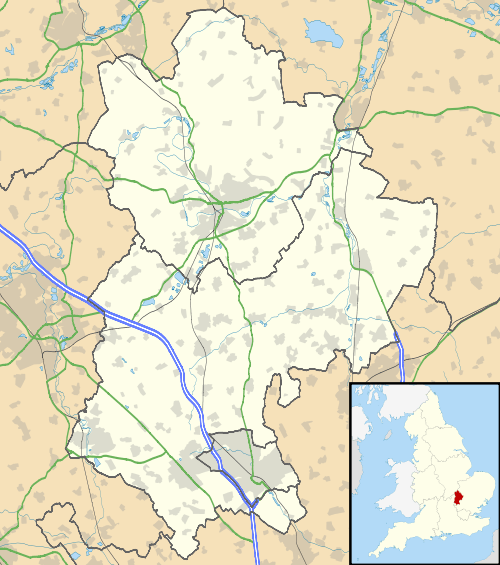RAF Stanbridge
| Royal Air Force Stanbridge | |
|---|---|
| near Leighton Buzzard, Bedfordshire, England | |
 Royal Air Force Stanbridge | |
| Coordinates | 51°54′39″N 000°38′20″W / 51.91083°N 0.63889°W |
| Type | Communications Centre |
| Site information | |
| Owner | Ministry of Defence |
| Controlled by | Royal Air Force |
| Open to the public | No |
| Site history | |
| Built | 1939 |
| In use | 1939 – 2013 |
RAF Stanbridge was a RAF station situated on the outskirts of Leighton Buzzard, Bedfordshire, England[1] and located 1.6 miles (2.6 km) west of the village of Stanbridge, Bedfordshire
It was a satellite site of RAF Henlow and was one of the smallest RAF Stations which looked after the Supply Central Computer System.[2]
History
Second World War
During the Second World War the station was a major base for secret communication traffic. A large number of underground tunnels filled with what was state-of-the art equipment were used to protect the equipment.[1]
Cold War
During the Cold War the station was still used as a vital communications base.[3]
In the early 1970s RAF Stanbridge had satellite sites at RAF Bampton Castle (Receiver site), RAF Weyhill (Transmitter site), RAF Edlesborough (Transmitter site), RAF Greatworth (transmitter site) and RAF Stoke Hammond (Receiver site). Stanbridge was then known as the Communications Control Centre (CCC or Commcen Central) and was the hub of the Defence Communications Network (DCN). The main building hosted Systems Control, a tape relay centre and later a Telegraphic Automatic Routing Equipment (TARE). The DCN connected sites all over the world by HF radio links using the two diverse transmitter sites and the diverse receiver sites. The Distant Terminals of these links included Canberra, Gan, Cyprus, Ottawa and Malta. Other UK sites involved were the RN site at HMS Forest Moor and RAF Oakhanger with its satellite earth-station.
- RAF Bampton Castle was a technical site only, equipped with HF radio receivers and an aerial farm and parented by RAF Brize Norton.
- RAF Edlesborough was a technical site only, equipped with HF radio transmitters and a large aerial farm and parented by RAF Stanbridge.
- RAF Stoke Hammond was a technical site only, equipped with HF radio receivers and an aerial farm and parented by RAF Stanbridge. It closed in the mid 1970s and the site was returned to the owner, leaving Bampton Castle as the only receiver site.
- RAF Greatworth had its own accommodation but was administratively parented from RAF Stanbridge. Like Edlesborough it was an HF radio transmitter site with a large aerial farm. The site opened in the 1930s and finally closed in 1992. It is now an industrial park known as Greatworth Park.[4]
These sites were equipped with radio equipment made by Marconi and Racal. During the 1970s the transmitters used were the Marconi HS series (HS31, HS51 and HS71) and their more modern MST series. The power of these transmitters ranged from 1 kW up to 30 kW and the two transmitter sites operated as a RED path and a YELLOW path to provide diversity to cope with atmospheric conditions, HF radio being at the mercy of the ionosphere. Aerials were of the dipole, rhombic or biconical designs being usually fed via twin wire feeders.
Post Cold War
Prior to 1999, RAF Stanbridge was responsible for providing Communications Support to its now closed satellite site at RAF Edlesborough.
The base was one of the smallest RAF Stations having only two Station buildings and 24 married quarters. It was part of a bigger site which was sold off by the Ministry of Defence (MoD) in 1999.[5]
The last station commander was Wing Commander M. G. Brown MBE MSc BEng RAF.[6]
The site was closed in March 2013,[7] but the formal closure ceremony happened during June 2012[8] with the personnel and families moving to RAF Wyton.[6]
Current use
In early 2016 planning permission was received, the RAF buildings filled in and/or demolished and work was begun in building houses and a 'Co-op local' convenience store. (April 2016)
Building work on the housing development commenced, but due to contractor issues is currently at a standstill. As part of the new development a local shop has been built and opened run by the Co-op. (November 2016)
See also
References
- 1 2 "RAF Stanbridge". BBC - Domesday. Retrieved 22 April 2012.
- ↑ "RAF Brampton Wyton". Royal Air Force. Retrieved 21 April 2012.
- ↑ "RAF base set to hold 1970s staff reunion in Leighton". Leighton Buzzard Observer. Retrieved 22 April 2012.
- ↑ "Introduction to RAF Greatworth". RAF Greatworth. Retrieved 20 November 2016.
- ↑ "Select Committee on Defence: Minutes of Evidence". House of Commons. 5 July 1999. Retrieved 15 January 2016.
- 1 2 "RAF Brampton Wyton". Royal Air Force. Retrieved 22 April 2012.
- ↑ "RAF base to close". Leighton Buzzard Online. Retrieved 20 November 2016.
- ↑ Lewis, Katy (21 June 2012). "RAF Stanbridge: The small base with a big history". BBC News. Retrieved 20 November 2016.
External links
- Gregory, Derwin. RAF Stanbridge, Leighton Buzzard, Bedfordshire: Desk Based Assessment (PDF). English Heritage. ISSN 1749-8775.
- www.rafgreatworth.com/
